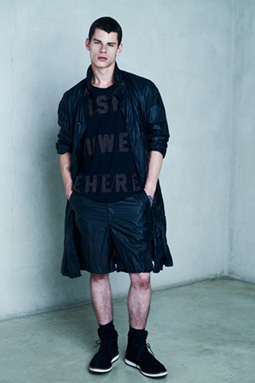NEW LARGE
Vent’anni orsono Gigli lo aveva ripreso dagli anni ’60, rivisto e corretto, idem Dolce e Gabbana che avevano insistito soprattutto sulla vestibilità del pantalone. E poi Costume National, Prada e Versace: sto parlando di slim fit . Dalla fine degli anni ’80 e per tutto un decennio, l’abito maschile ha subìto una metamorfosi che ha raggiunto il suo apice con la prima collezione firmata Slimane per Christian Dior, nel 1999. L’ingresso di Hedi Slimane presso il gruppo LVMH determinò un’ ulteriore drastica trasformazione dell’ abbigliamento maschile; e naturalmente si rimpicciolirono anche camicie e maglie e la larghezza della cravatta si asciugò fino a 4 centimetri. Da allora, solo un tentativo, da parte di Stefano Pilati per Yves Saint Laurent, di tornare ai tessuti cedevoli e alle forme comode del primo Armani, e qualche raro indistruttibile patito dell’over, come Yamamoto, che persevera con puntuale coerenza nella sua linea stilistica. Tutto ciò, senza grande successo. Sarà che Pilati non è stato sorretto dal medesimo battage pubblicitario di Gigli e Dolce & Gabbana dei tempi che furono, ma neppure di quello Dior nei primi anni di Slimane. O sarà perché il “largo” dona a pochi anzi a pochissimi. Tuttavia, pur senza eccessi, nelle ultime sfilate dell’anno scorso (collezioni p/e 2012), qua e là si è visto qualcosa di large. La moda è ciclica: hanno stufato i bottoni della camicia che rischiano di strapparsi, i pulloverini super aderenti che segnano perfidamente ogni minimo difetto fisico, le giacche che si abbottonano a fatica e i pantaloni che ogni volta che ti alzi dalla sedia restano appiccicati al polpaccio. Anche le cravatte troppo strette sono superate. Si volta pagina? Naturalmente non ci potrei giurare: secondo me alle sfilate di questo gennaio ne vedremo delle belle.
Twenty years ago, Romeo Gigli picked them from the 60s, adjusting the shapes accordingly to his own taste. Dolce & Gabbana, at the beginning of their career, did exactly the same, improving the shape and fit of trousers. Then again: Costume National, Prada and Versace. I’m talking about tight-fitting suits. Since the late 80s, for a whole decade, there has been a metamorphosis concerning men suits, reaching it’s peak with a 1999 Hedi Slimane collection for Christian Dior Homme. Slimane, joining the LVMH group, determined a drastic transformation in menswear. Shirts and sweaters became tighter, ties got skinnier till 4 cm. Since then, only Stefano Pilati for Yves Saint Laurant Homme tried to get back to the stretched fabrics and comfortable shapes of the first Armani. A rare exception is the irreducible oversize supporter, Yohji Yamamoto, who is pushing forward, keeping consistent with his own trademark style, however not getting big responses. Perhaps it’s that Pilati has not been supported by the same advertisement ballyhoo that Gigli and Dolce & Gabbana had back in the days, even the advertisement that Dior had during the years of Slimane. Or maybe it is because oversized clothing does not flatter the majority of people. Still, oversized looks have been spotted at the latest fashion shows (s/s 2012 collections). It’s in the air and fashion, being a cycling process, is feeling a need for change. After all, there’s a limit to everything: way too tight shirts, causing you a button-loss problem, close-fitting sweaters which awfully marks any of your body imperfections, blazers you can hardly button up, trousers that each time you stand stick to your calves. Even slim ties are out of date. Is it time to turn the page? I wouldn’t bet on it, but I have the feeling there will be surprises in January.








